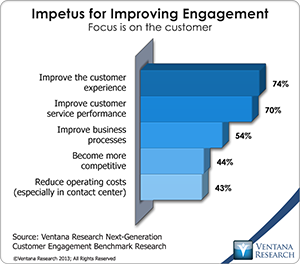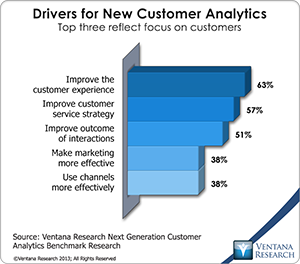Competition for customers is more intense today than ever before, and companies struggle to differentiate themselves from the competition. Our research repeatedly finds that customer experience is a key differentiator.
Competition for customers is more intense today than ever before, and companies struggle to differentiate themselves from the competition. Our research repeatedly finds that customer experience is a key differentiator. Our research into next-generation customer engagement said the impetus for improving  engagement is to improve the customer experience in almost three quarters (74%) of participants. One increasingly popular way to do this is to use customer journey maps, which show how companies plan to engage with customers: at what times, through which channels, at which touch points and with which business units or using which self-service technologies. Our benchmark research into customer relationship maturity shows that two-thirds (67%) of very customer-focused companies use customer journey maps. The top four uses are to develop more customer-focused employee training (by 78%), personalize customer experiences (76%), enhance customer experience processes (73%) and drill down on customer experience processes to the customer segment level (73%). Typically producing these maps has been a manual process, perhaps using process mapping tools; in these cases few companies were able to capture and visualize actual journeys. However, as more business units engage with customers and companies deploy multiple channels of engagement – including self-service – improving the customer experience and mapping the customer journey become more complex, and to keep up companies have to invest in processes and tools that help them automate the process of producing maps and capture data about and visualize actual customer journeys.
engagement is to improve the customer experience in almost three quarters (74%) of participants. One increasingly popular way to do this is to use customer journey maps, which show how companies plan to engage with customers: at what times, through which channels, at which touch points and with which business units or using which self-service technologies. Our benchmark research into customer relationship maturity shows that two-thirds (67%) of very customer-focused companies use customer journey maps. The top four uses are to develop more customer-focused employee training (by 78%), personalize customer experiences (76%), enhance customer experience processes (73%) and drill down on customer experience processes to the customer segment level (73%). Typically producing these maps has been a manual process, perhaps using process mapping tools; in these cases few companies were able to capture and visualize actual journeys. However, as more business units engage with customers and companies deploy multiple channels of engagement – including self-service – improving the customer experience and mapping the customer journey become more complex, and to keep up companies have to invest in processes and tools that help them automate the process of producing maps and capture data about and visualize actual customer journeys.
I covered details of this complexity in my review of lessons learned during 2014. I recommend thinking of the customer journey in four dimensions:
- Customer business journey. Customers go through a series of steps in evaluating and using new products and services. It begins with learning about them (often by perusing marketing campaigns, searching the Internet and getting word-of-mouth recommendations), then purchasing those they select, beginning to use them, which might require some initial support, and accessing ongoing customer service. Satisfied customers are likely to repeat the process and provide opportunities for upselling and further purchases. Our benchmark research into recurring revenue shows that this journey has become more complex as more companies move from one-off sales to providing ongoing, Internet-based services – for example, software vendors providing cloud-based rental of applications rather than licensing on-premises products. The customer business journey thus complicates the relationship between marketing, sales, customer service, finance and HR departments and requires processes that flow across business unit boundaries, sharing of customer data, information and metrics, and collaboration between everyone involved.
- Customer engagement journey. This often is what is called “the customer journey”; it seeks to map the channels and touch points that prospects and customers use to engage with companies. To do this companies need to understand every point of engagement, how people travel across channels to achieve their objectives, and the outcomes of interactions. To understand them requires capturing every interaction on every channel, business outcomes (Did the customer make a purchase?) and the customer’s emotional state during and after each interaction.
- Internal business journey. Most companies are organized into separate business units. These often have their own processes, systems and metrics, and typically each deals with prospects and customers at different points in the customer business journey – in isolation from the other business units. To ensure consistency of the customer experience, companies should develop and share a single view of customers and ensure that decisions and actions are based on that common view; they also should take into account the likely impacts of those decisions and actions on other points in the business journey.
- Product and service journey. Most companies have multiple products and services; some are simple and some complex. Prospects and customers therefore engage with companies in different ways and channels, depending on the product or service. Companies therefore have to consider all the above journeys for each product or service.
Managing the complexity of the customer journey in all its facets  requires specialist tools. Our research into next-generation customer analytics shows that to manage this complexity a majority are turning to customer analytics to improve the customer experience (63%), their customer service strategy (57%) and the outcomes of interactions (51%). Analytics requires data, and the research finds difficulty here; nearly two-thirds (63%) said that the data they require is not readily available, and almost half spend most of their time preparing data (47%) and reviewing data for quality (43%). This is a serious impediment to mapping the customer engagement journey, which requires capturing data from multiple communication systems (including the telephone, email and Web servers, mobile phones and social media), having processes and systems that can link transactions from one communication system to the others, and visualizing the outputs in graphic forms that are easy to understand. The outputs should clearly show the business outcomes of journeys, such as whether a customer renewed a contract. Indeed outcomes enable organizations to identify weaknesses in existing journey processes and guide them to improve future interactions.
requires specialist tools. Our research into next-generation customer analytics shows that to manage this complexity a majority are turning to customer analytics to improve the customer experience (63%), their customer service strategy (57%) and the outcomes of interactions (51%). Analytics requires data, and the research finds difficulty here; nearly two-thirds (63%) said that the data they require is not readily available, and almost half spend most of their time preparing data (47%) and reviewing data for quality (43%). This is a serious impediment to mapping the customer engagement journey, which requires capturing data from multiple communication systems (including the telephone, email and Web servers, mobile phones and social media), having processes and systems that can link transactions from one communication system to the others, and visualizing the outputs in graphic forms that are easy to understand. The outputs should clearly show the business outcomes of journeys, such as whether a customer renewed a contract. Indeed outcomes enable organizations to identify weaknesses in existing journey processes and guide them to improve future interactions.
Data also plays a key role in the customer and internal business journeys. Typically it is captured and stored in a variety of business applications such as CRM, ERP, customer feedback, billing and others. To produce a complete view of the customer, including the individual’s emotional state and likely next actions requires the use of systems that can extract data from all these systems, rationalize it and produce analysis and dashboards in forms suitable for different users.
The ultimate goal should be to combine all these sets of data into a single view of the customer. Where possible the systems should work in real or near real time so all users make decisions based on the most up-to-date information as when  a contact center agent is asked for the status of a promised delivery. Furthermore the systems should support access to information on mobile devices to enable employees away from their desks to be notified of issues needing immediate action. Our research shows that getting it right can deliver real benefits; chief among them are improved customer experiences (55%), better analysis of the business (52%) and better alignment across the organization (51%). Companies long have talked about having a “360-degree of the customer,” and new systems that can process structured and unstructured data now make it possible to produce such a view. Some of these tools use speech and text analytics to better understand the customers’ emotional states and anticipate their next actions. New systems that can capture all interaction data and combine this with business data make it possible to map actual rather than hypothetical customer journeys and provide analysis that guides companies to improve processes and training and through it future experiences. Tools that manage customer experience and journey maps are available from a variety of vendors. I recommend comparing these systems and choosing the one that best enables your organization to start mapping its customers’ journeys.
a contact center agent is asked for the status of a promised delivery. Furthermore the systems should support access to information on mobile devices to enable employees away from their desks to be notified of issues needing immediate action. Our research shows that getting it right can deliver real benefits; chief among them are improved customer experiences (55%), better analysis of the business (52%) and better alignment across the organization (51%). Companies long have talked about having a “360-degree of the customer,” and new systems that can process structured and unstructured data now make it possible to produce such a view. Some of these tools use speech and text analytics to better understand the customers’ emotional states and anticipate their next actions. New systems that can capture all interaction data and combine this with business data make it possible to map actual rather than hypothetical customer journeys and provide analysis that guides companies to improve processes and training and through it future experiences. Tools that manage customer experience and journey maps are available from a variety of vendors. I recommend comparing these systems and choosing the one that best enables your organization to start mapping its customers’ journeys.





